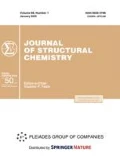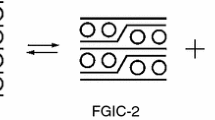Conclusion
The results obtained in the present work show that the use of the method proposed in [3] to study the structure of intercalated compounds of graphite fluoride has made it possible to resolve in principle the question of the distribution of the C2FX layers along the z axis in these compounds and to determine the nature of the arrangement of the inserted molecules between the layers.
In intercalated compounds of stage I with an “expanded structure” of the filled layer, the molecules of the inserted solvent are distributed chiefly in two layers between the C2Fx layers, whereas in the compounds with the “simple structure” they are distributed in one layer.
In the intercalated compounds of stage II, the thickness of the unfilled layer is 6 Å, and the thickness of the filled layer coincides with the thickness of the layer in the corresponding inercalated compounds of stage I with the “simple structure” of the filled layer.
The fluorine atoms in C2Fx are arranged symmetrically on each side of the carbon layer.
In the intercalated compounds heated to a temperature of ≈200°C, the graphite fluoride layers form stacks with a distance of 6.0 Å between the layers.
On the basis of the results obtained, it has been suggested that the most probable reason for the strong retention of the inserted component in the intercalated compounds of stage II is the paired linking of the edge sections of the C2Fx layers.
Similar content being viewed by others
Literature Cited
N. F. Yudanov, A. S. Nazarov, and I. I. Yakovlev, Summaries of Papers Presented at the Sixth All-Union Symposium on the Chemistry of Inorganic Fluorides [in Russian], Novosibirsk, 1981, p. 94.
N. F. Yudanov, L. I. Chernyavskii, and I. I. Yakovlev, Summaries of Papers Presented at the Seventh All Union Symposium on the Chemistry of Inorganic Fluorides, [in Russian], Dushanbe, Nauka, Moscow, 1984, p. 356.
Yu. S. D'yakonov, The development of a direct method for determining mixed-layer structures, in: The Crystal Chemistry and Structure of Minerals [in Russian], Nauka, Leningrad, 1974, p. 33.
V. A. Drits and B. A. Sakharov, The X-Ray Diffraction Study of Mixed-Layer Minerals [in Russian], Nauka, Moscow, (1976).
V. I. Lisoivan, S. A. Gromilov, and N. F. Yudanov, Zavodsk. Lab.,52, No. 3, 36 (1986).
V. A. Frank-Kamenetskii (editor), The X-ray Diffraction Study of the Basic Types of Ore-Forming Minerals [in Russian], Nedra, Leningrad, 1983.
Additional information
Institute of Inorganic Chemistry, Siberian Branch, Academy of Sciences of the USSR. Translated from Zhurnal Strukturnoi Khimii, Vol. 29, No. 3, pp. 78–83, May–June, 1988.
Rights and permissions
About this article
Cite this article
Yudanov, N.F., Chernyavskii, L.I., Lisoivan, V.I. et al. Structure of intercalated compounds of graphite fluoride C2FX . J Struct Chem 29, 412–418 (1988). https://doi.org/10.1007/BF00743998
Received:
Issue Date:
DOI: https://doi.org/10.1007/BF00743998




